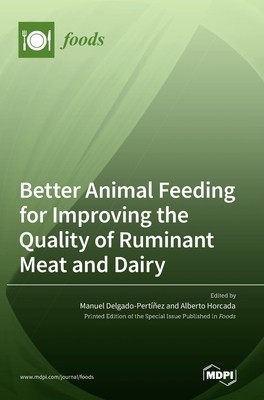
- We will send in 10–14 business days.
- Publisher: MDPI AG
- ISBN-10: 3036543171
- ISBN-13: 9783036543178
- Format: 17 x 24.4 x 1.3 cm, hardcover
- Language: English
- SAVE -10% with code: EXTRA
Better Animal Feeding for Improving the Quality of Ruminant Meat and Dairy (e-book) (used book) | bookbook.eu
Reviews
Description
Consumers are looking for healthier foods. Animal nutrition is one of the most important environmental factors in product quality, and significantly influences meat and milk and its dairy products. So emphasis is often placed on improving quality though animal feeding. A main target in improving meat and dairy nutritional characteristics is the enhancement of lipid quality, which can be achieved by increasing the content and composition of beneficial fatty acids. Factors such as forage: concentrate ratio, dietary fat supplements, etc. have an essential effect on animal dairy and meat quality. A few studies have shown that meat and dairy from ruminants in pasture is enriched in bioactive substances of natural origin. These animals are also able to utilize increasing amounts of by-products or "unconventional" animal feedstuffs, which can improve the healthful properties of products. Epidemiological studies that find inverse associations between eating red meat and health do not distinguish between meat from livestock fed high-grain diets and livestock foraging on phytochemically rich mixtures of plants. Despite their alleged benefits, research has not elucidated linkages among plant diversity or alternative feedstuffs with potential functional properties in ruminant diets and human health. In addition, dietary manipulations favoring polyunsaturated FA incorporation in dairy and meat lipids increase the risk of lipoperoxidation, which can be efficiently prevented by use of dietary antioxidants. This book collected articles addressing optimal dietary composition for ruminant production to improve the quality of meat and dairy.
EXTRA 10 % discount with code: EXTRA
The promotion ends in 9d.04:09:35
The discount code is valid when purchasing from 10 €. Discounts do not stack.
- Publisher: MDPI AG
- ISBN-10: 3036543171
- ISBN-13: 9783036543178
- Format: 17 x 24.4 x 1.3 cm, hardcover
- Language: English English
Consumers are looking for healthier foods. Animal nutrition is one of the most important environmental factors in product quality, and significantly influences meat and milk and its dairy products. So emphasis is often placed on improving quality though animal feeding. A main target in improving meat and dairy nutritional characteristics is the enhancement of lipid quality, which can be achieved by increasing the content and composition of beneficial fatty acids. Factors such as forage: concentrate ratio, dietary fat supplements, etc. have an essential effect on animal dairy and meat quality. A few studies have shown that meat and dairy from ruminants in pasture is enriched in bioactive substances of natural origin. These animals are also able to utilize increasing amounts of by-products or "unconventional" animal feedstuffs, which can improve the healthful properties of products. Epidemiological studies that find inverse associations between eating red meat and health do not distinguish between meat from livestock fed high-grain diets and livestock foraging on phytochemically rich mixtures of plants. Despite their alleged benefits, research has not elucidated linkages among plant diversity or alternative feedstuffs with potential functional properties in ruminant diets and human health. In addition, dietary manipulations favoring polyunsaturated FA incorporation in dairy and meat lipids increase the risk of lipoperoxidation, which can be efficiently prevented by use of dietary antioxidants. This book collected articles addressing optimal dietary composition for ruminant production to improve the quality of meat and dairy.


Reviews